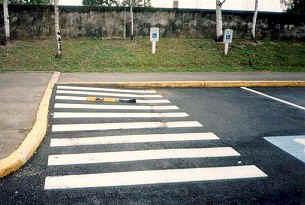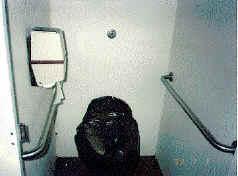Test Your ADA IQ
Check your understanding of The Americans with Disabilities Act.
The Americans with Disabilities Act is a complex law, with sometimes confusing technical standards, set forth in the ADA Accessibility Guidelines (ADAAG). We have added and updated a few questions per the 2010 ADA Standards adopted by USDOJ 9/15/2010 which were fully enforceable 3/15/2013.
There was an 18-month grace period until 3/15/2012 during which either the original 1991 Standards or the New 2010 Standards may be used as a "safe harbor" for compliance with the following exceptions: There are new scoping areas, such as public pools and spas, which must meet the 2010 Standards by that date. Any renovated areas to exisiing facilities must meet the new 2010 Standards. After 3/15/2012, the 2010 Standards only must be used. There are many additional subtleties in the Regulations. Please contact us with questions.
The new 2010 ADA Standards reduce the side reach to 48", the same as front reach range. The new standard is more stringent in this case. This is consistent with most Building Codes, which adopt the International Building Code (IBC) / ANSI A117.1 as their standard.
The ADA requires owners of public accommodation facilities to make their existing facilities accessible to and usable by individuals with disabilities to the maximum extent feasible, unless it can be demonstrated to be structurally impractical or if it threatens or destroys the historic significance of a registered facility, and only to the extent that it can be made accessible without assuming disproportionate costs.
A 1:2 beveled edge is required at thresholds for swing doors with thresholds between 1/4" and 1/2" high. The New 2010 Standards permit a 3/4" threshold at existing buildings, with a 1:2 bevel. For level changes in general on accessible routes, when the level change is more than 1/2", it requires a ramp, which must be a 1:12 slope (8.33%). For example, a 1" level change will require a 12" long ramp.

The projecting, built-up asphalt curb ramp projects into the side access aisle, which is supposed to be very level, 1:50 slope. Recessing a curb ramp into the walkway at the head of the stall is a compliant solution. FYI, Requiring people to move behind the parked cars to get to a walkway is not accessible.
Interior doors require 5 lbs. force to open them. This is very little force. Exterior door force is not stated, but rather "reserved" for future requirements. The primary reason for this is that wind force and positive air pressure in most buildings would prevent full door closure at 5 lbs. force.

This toilet may have been compliant in another era. Current accessible stalls are much wider, enabling easier, and different ways to for user transfer to the toilet. The 2010 ADA Standards require 60" clear width, with no lavatory encroaching at toilets.
Accessible parking stalls may share a common access aisle. Van accessible stall access aisles are 8' wide. Standard accessible stall access aisles are 5' wide. The stalls themselves are 8' wide.
For existing public accommodation buildings there is a specific, limited exemption as follows. " Elevators are not required in places of public accommodation and commercial facilities that are less than three stories or that have less than 3000 square feet per story unless the building is a shopping center, a shopping mall, or professional office of a health care provider, or other type of facility as determined by the Attorney General." - ADAAG 4.1.3 (5)(a) This exemption does not apply to buildings owned by public entities per ADA Title II or Federal Buildings, for which the ADA does not apply.
In addition to clearance and hardware, there are other parameters for door approach. 18" clear is required on the pull side of the door at the latch side. 12" clear is required on the push side of a door where there is a latch set and door closer. Varying degrees of maneuvering space is required, depending from which direction a door is approached.
Except for curb ramps or ramps with a rise of less than 6". A ramp has a slope between 1:20 (5%) and a the maximum of 1:12 (8.33%). Compliant ramps have compliant handrails on both sides, landings, edge protection etc.
This is a bit of a trick question. An Architect designing a building is required to comply with all applicable codes and regulations. A building department, from which a building permit is obtained, does not typically check for compliance in detail. They may or may not pick up some non-compliant items. Therefore, in the real world, buildings do get built that are substantially compliant, but may not meet all requirements. We consult to other design professionals, because ADA is a specialty area.
Power assisted door openers are excellent for accessibility, but not required. In fact, the maximum door operating force for exterior doors is not specified, but is often set at the 8.5 lbs. maximum per prior regulations. Interior doors require 5 lbs. maximum force. Power assisted door operators can also solve many sloped approach and narrow door pair problems.
This is now a trick question after the adoption of the new 2010 Standards. The 2010 Standards delete the dectable warnings (pending future anticipated adoption in public right of way standards). However, many buiding codes will still require them. The 1991 Standards, which may be used as a "safe harbor" for existing buildings requires them.
Anyone with "legal standing" can file a complaint with the Justice Department if they believe there are barriers in public accommodations in your facility. Per Standards Section 36.501, "Any person who is being subjected to discrimination on the basis of disability in violation of the Act or this part or who has reasonable grounds for believing that such person is about to be subjected to discrimination...may institute a civil action for preventative relief..." The Attorney General may also file suit following a compliance review if there is reasonable cause to believe there is a pattern or practice of discrimination. We highly advise Owners to have at least made a "good faith effort" at removing barriers. A Facility Accessibility Survey is a good first step.
Not necessarily. The push button also must require 5 lbs. force or less, and should also be designed to stay on for a reasonable amount of time. This latter item may be specified in the Building Code. The push button requirements would also apply to push button toilet flush valves, which usually also have the issue of not being on the wide side of the toilet stall.
The stated dimensions are compliant only if there is a 36" (in CA 48") landing at the top of the curb ramp. If there is less, then the slope of the flared sides needs to be 1:12 (8.33%), the same as the face. This enables a wheelchair user to turn in an arc on the ramp.
A built-up curb ramp of 1:12 slope (8.33%) and 1:10 (10%) side flares is compliant , but not in all situations. The projecting curb ramp is not allowed to project into the access aisle of an accessible parking stall. It would have to be adjacent to it, effectively making a wider access aisle. Access aisles are allowed a maximum 1:50 (2%) slope.

